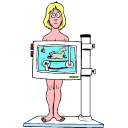 | |
|
|
|
The Equilibrium of Acids and Bases
|
Acids |
Bases |
|
Operational Definitions : If you recall, operational definitions are based on what you can actually observe in the lab.
|
Operational Definitions : If you recall, operational definitions are based on what you can actually observe in the lab.
|
|
Conceptual Definitions : The Arrhenius definition of an acid: a substance that releases H+1.Example: HCl(aq) --> H+1(aq) + Cl-1(aq) Very important: Always remember that when considering acids and bases, the H+1 ion is aqueous, in other words, it is dissolved in water. |
Conceptual Definitions: The Arrhenius definition of an acid: a substance that releases OH-1. Example: NaOH(aq) --> Na+1(aq) + OH-1(aq). Very important: Always remember that when considering acids and bases, the OH-1 ion is aqueous, in other words, it is dissolved in water. |
|
Everyday substances that are acidic (pH <7) include fruits (contain citric and/or malic and/or tartaric acids) soda drinks(carbonic acid and/or phosphoric acid), toilet bowl cleaner (HCl), muriatic acid brick cleaner (HCl). |
Everyday substances that are alkaline (basic) (pH >7) include baking soda (NaHCO3), soap, milk of magnesia (Mg(OH)2),ashes (contain KOH) and household ammonia (NH4OH). |
2.Connection Between Kequilibrium and Acids/Bases.
a. Kw and pH Formula
A small amount of water constantly dissociates into H+1 and OH-1 ions. Of course these reassociate into water at the same rate to create the following equilibrium:
H2O(l) = H+1(aq) + OH-1(aq).
Kw = [H+1] [OH-1]
Notice we give water's equilibrium constant a special name: " Kw".
Experimentally Kw = 1.0 X 10-14, so you can see from the small value for K that there are very few H+1 and OH-1 ions in water.
Let's sidetrack for a minute: In chemistry "p" is an abbreviation for -log. It was introduced by a Danish biochemist, Sorenson in 1909— p is the initial letter of the German word potenz = power.
So pH = - log [H+1] or rearranging it mathematically, [H+1] =10-pH

If [H+1] = 1.0 X 10-2 M in your stomach, what is its pH?
SolutionpH = - log [H+1]
pH = -log (1.0 X 10-2) = - (-2) = 2.
Example 2
If the pH of tomato juice = 3.5, what is its [H+1]?
Solution[H+1] =10-pH
- [H+1] =10-3.5 = 0.000316 mole/L or 0.000316 M
b. Why Is Neutral Stuff at a pH=7 ?
In pure water, or in any neutral solution, [H+1] = [OH-1], so by substituting, the expression
Kw = [H+1] [OH-1] becomes
Kw = [H+1] [H+1] or
- X 10-14 = [H+1]2. Square rooting both sides:
- X 10-7 = [H+1]. But since pH = - log [H+1],
pH = 7.
c. Why Is Acidic Stuff at a pH <7 ?
- Acids contain a lot more H+1 than OH-1. (You might be wondering why there is any OH-1 in acids. Well there is always a bit because it comes from water. Remember its equilibrium.).
- As a result, [H+1] > 1 X 10-7 .
- Take the log of both sides:
- log [H+1] >-7. Now multiply both sides by –1. Remember math: inequality flips when multiplying by a (-).
- -log [H+1] <-(-7).
- pH < 7 for acidic substances.
d. Why Is Alkaline (basic) Stuff at a pH >7 ?
- Bases contain a lot more OH-1 than H+1. Even in bases there is always a bit of H+1 that comes from water but of course there is even less than you would find in neutral water.
- As a result, [H+1] < 1 X 10-7 .
- Take the log of both sides:
- log [H+1] <-7. Now multiply both sides by –1. Remember math: inequality flips when multiplying by a (-).
- -log [H+1] >-(-7).
- pH > 7 for alkaline substances.
- [H+1] [OH-1] = 1 X 10-14.
- Log both sides:
- log ([H+1] [OH-1]) = -14. Remember from math : log AB = log A + log B:
- log[H+1] + log[OH-1] = -14. Multiply through by (-1):
- -log[H+1] - log[OH-1] = 14.
- pH + pOH = 14 , and note that pOH = -log[OH-1] or [OH-1] =10-pOH
- Example 2 : If an aqueous sodium hydroxide solution has [OH-1] = 0.01 M, what its pOH? Its pH?
- pOH = -log[OH-1]
- = -log[0.01] = 2
- pH = 14 – pOH = 14 – 2 = 12.
- Example 3:
- Complete the following table:
e. The concept of pOH
|
|
[H+1] mol/L |
[OH-1] mol./L |
pH |
pOH |
Neutral, acidic, or basic |
|
A |
1 x 10-3 |
|
|
|
|
|
B |
2.0 X 10-4 |
|
|
|
|
|
C |
|
|
3 |
|
|
|
D |
|
6 |
|
|
- Solution
|
|
[H+1] mol/L |
[OH-1] mol./L |
pH |
pOH |
Neutral, acidic, or basic |
|
A |
1 x 10-3 |
|
Step1 pH =-log(1 x 10-3) = 3 |
Step 3 pOH =14 – pH =14 –3 = 11 |
Step 2 Acidic, because pH<7. |
|
B |
5.0 X10-11 |
2.0 X 10-4 |
14-3.70 = 10.3 |
3.70 |
alkaline |
|
C |
10-11 |
|
11 |
3 |
alkaline |
|
D |
10-6 |
10-8 |
6 |
8 |
acidic |
- Notice that a difference of "only" 3 pH units between two acids is a lot bigger than the numbers seem to indicate. A pH =3 solution is 1000 times more acidic ( has a 1000 times more H+1) than a pH = 6 solution. See above table.